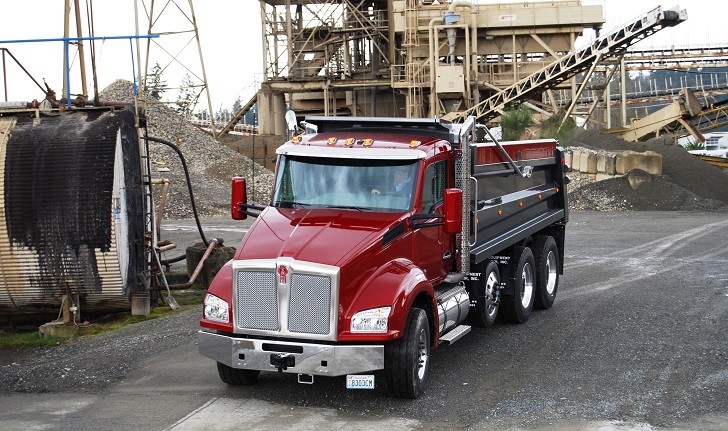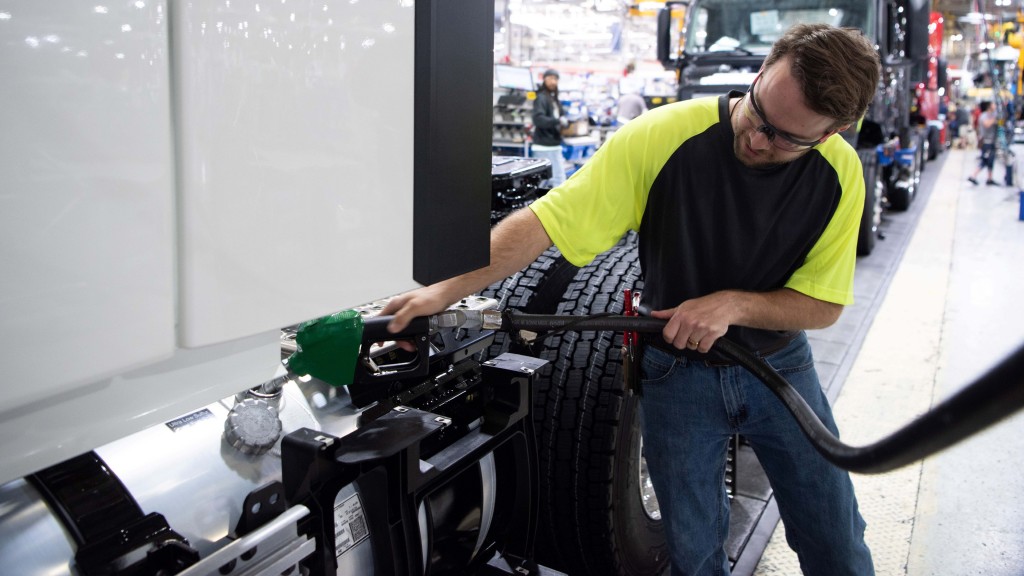
In today’s market, it is especially important to consider spec’ing your next new dump truck with both vehicle productivity and driver comfort and satisfaction in mind.
Bed materials, shape, capacity, and other features go a long way toward determining a truck’s productivity. If your choice of dump body helps to haul a half-ton more than the next guy, you’re not just going to be more profitable. That half-ton is going to win you contract after contract over the vehicle’s life. But payload is only part of the productivity equation.
“The biggest trend in dump truck design is driver comfort and satisfaction,” says Kevin Baney, chief engineer at Kenworth Truck Co. A larger interior, a more logical dash and switch layout, better braking performance, and information centers with instant feedback are features that can improve the driver’s experience both on the road and at the job site.
“The body builder largely defines a vehicle’s allowable payload based on what and where you’re hauling,” Baney explains. “But the cab and chassis play a vital role in keeping drivers happy and productive.”
Many of these design elements have evolved over the years, especially as truck manufacturers account for the wider variety of body types and experience levels in the workforce today. Here are six features to help truck owners focus on filling both the driver’s seat and the dump bed:
1. More Interior Space
Work boots, hard hats, gloves, heavy clothes, tools—a cab should accommodate not only the operator but the personal equipment he uses on the job.
There are three ways to create more space in a cab, says Baney:
The cab for the Kenworth T880 vocational truck, which was introduced two years ago, is a case study in all three areas.
At 2.1 meters (82.7 inches) wide, the T880 cab is 10 inches wider than its predecessor and has 23 inches of room between the seats. Instead of offering an extended day cab option, Kenworth added 4 inches of space behind the seats to allow for more seat travel. There’s enough room on the back wall for hooks to hang coats and hard hats.
In the footwell, the T880 uses firewall-mounted hanging pedals instead of floor-mounted pedals. An air-assisted hydraulic clutch requires only half the pressure of a traditional clutch so it’s easy to engage without a lot of leg movement for less fatigue. The smaller “doghouse” provides more floor area and helps reduce clutter.
“Visibility is one of the most important operating features at a job site,” says Baney. The combination of a tall windshield and lower windshield base in the T880 resulted in a 50 percent larger windshield than Kenworth’s previous generation cab, giving the driver a better view of the terrain, obstacles, and workers around the truck.
With its driver-first mentality for the T880, one Kenworth goal was to optimize comfort. “The truck’s interior should accommodate and adjust to a wide range of body types and sizes,” Baney says. “No fleet owner wants to hear a driver say he’s leaving or needs time off because he’s uncomfortable in the cab. The cab should adjust to the driver, not the other way around.”
2. Powertrain
Engine technology has evolved, and truck owners who aren’t aware risk spec’ing more power than they need. “A 13-liter engine, with the proper power band, can rival a 15-liter engine in many vocational-truck applications,” says Baney.
The PACCAR MX-13 engine delivers up to 500 hp and 1,850 lb-ft of torque, capturing 85 percent of the power curve yet saving 300 or more pounds versus a 15-liter engine. The design reduces in-cab noise levels significantly for a more comfortable driving environment. The selection of a PACCAR MX-13 also allows for the T880’s shorter, 116.5-inch BBC hood configuration for improved visibility.
Nor does a 13-liter engine limit your choice of transmission. Baney says Eaton’s 8LL and 18-speed manuals remain leading specs among dump truck buyers at Kenworth, but the need to attract and retain drivers is pushing the industry toward automated and automatic transmissions. Operating a manual transmission requires more effort and concentration on the road and in the work zone.
Eaton’s UltraShift PLUS transmissions feature the highest torque capacity in the industry, ranging from 1,450 lb-ft through 2,250 lb-ft, as well as best-in-class startability and ratio coverage. Each has driveline protection features such as stall prevention, engine over-speed protection, clutch abuse protection, and auto gear selection.
3. Braking and Stability Control
Many dump truck owners previously considered front disc brakes a delete-option. Baney says that’s changing. “While drivers appreciate the performance of disc brakes and owners like the ease of maintenance and light weight, both are also keenly aware of the scrutiny dump trucks face from inspectors,” he explains.
Drum brakes were once again the No. 1 out-of-service item during roadside inspections, according to Road Check 2014 performed in the United States, Canada and Mexico by the Commercial Vehicle Safety Alliance.
“The advantage with disc brakes is that pad and rotor wear is far easier to see during a driver’s pre-trip—there’s no crawling under the truck. Drivers say they feel more confident when they pull into an inspection station with a disc-brake-equipped dump truck,” says Baney.
The combination of disc brakes and a 6S/6M ABS configuration (six-wheel speed sensors and six modulators that transmit pulsating air when a wheel locks) provides all-wheel and individual-wheel braking control. Because it can respond to each wheel individually, ABS provides better performance in split-coefficient situations where one wheel is on a slippery surface like a steel plate and another is on dry pavement.
Finally, advanced braking systems can provide active safety features like roll and directional (yaw) stability control. “Dump truck loads are dynamic—they move—and no two payloads are placed exactly the same,” Baney says. “Drivers who have experienced advanced braking systems on highway trucks want the level of control that disc brakes and active safety systems can provide.”
4. Information Centers
Dump trucks are supplementing traditional dial gauges with data-rich digital displays. The Kenworth T880 is one example.
Centered above the tachometer and speedometer is a 5-inch, high-resolution, color display—the Kenworth Driver Performance Center. Digital gauges provide general information like time and temperature but also real-time information about the truck’s operation, including oil and transmission temperatures, a sweet-spot visualization of RPM and fuel economy, engine torque, PTO status, and pop-up diagnostic alerts.
Kenworth also now offers the new Kenworth Nav+ HD. The system incorporates a hands-free communication system with Bluetooth connections and voice commands as well as turn-by-turn navigation, USB port, camera inputs, AM/FM/weather bands, and iPod or MP3 integration, among other features. Specific to dump trucks, Nav+ HD offers up to 30 “virtual” gauges in the screen to supplement the dash gauges.
“On the highway, the driver wants instant feedback about the truck’s operation. In the work zone, the driver’s needs to concentrate on the status of the payload, PTO, dump bed, and what’s happening around the truck,” Baney says. “The idea is to give the driver the right information at the right time for enhanced productivity.”
5. Switches
Using electric-over-air (EOA) switches to control air solenoids (which control PTO engagement) provides new control and interlock opportunities.
In the past, safety interlocks were manually installed by the body builder through solenoids, micro switches, and relays. Today, EOA switches allow the truck manufacturer to take advantage of the truck’s ECUs and provide electronically controlled safety interlocks from the factory.
“With EOA switches, we can program it so if a certain condition is not met, the switch will not activate the component on the truck,” Baney says. It’s useful, for example, for the ECU not to allow the PTO to function unless the parking brake is set, preventing the dump bed from raising accidentally.
EOA switches also keep air lines for transmission PTO controls from routing inside the cab, eliminating the noise that comes with air-actuated switches.
6. HVAC
Part of the HVAC system, automatic temperature control uses a computer and sensors to monitor temperatures and humidity levels inside and outside the cab at duct outlets and at the evaporator. It can fine-tune the temperature inside the cab automatically, controlling which ducts the hot or cold air blows out of, as well as the fan speed and the position of the recirculation door.
One factor in HVAC performance that’s often overlooked: the door seals. “A more robust seal design will help maintain pressure inside the cab,” Baney explains, “keeping out dust, dirt, and other airborne particles that can irritate the driver and interfere with the performance of the air conditioner.”
Finally, consider how easy it is to inspect the cabin air filter. A dirty filter can restrict air flow through the vents, leading to complaints about fan speed or ineffective A/C. Kenworth provides access to the cab filter through the glove box, making a filter inspection about a 5-minute task.
Team Effort
The truck OEM, truck dealer, and body builder work together to produce a truck that’s capable of being productive and profitable. Once that truck is delivered, the driver is the one most responsible for making sure those plans are realized.
“For years, when fleet owners took delivery of a new dump truck, their first thought was about how to fill it,” Baney says. “Now they have to think about where to find a qualified driver for that truck. When you spec your dump truck starting with the body, consider first which body matters most.”
SIDEBAR:
Working with Body Builders
The biggest misconception among dump truck buyers is that they’re on their own during the spec’ing process.
“Among the truck dealer, truck OEM, and body builder, buyers have tremendous resources available to help them spec the truck they need,” says Kevin Baney, chief engineer at Kenworth Truck Co. “When you’re looking at truck and body suppliers, ask how the two communicate. Have they worked together before? Are they talking to one another and sharing ideas on a steady basis?”
A generation ago the spec’ing process involved paper schematics and body-builder manuals being couriered from here to there, with fingers crossed that there were no mistakes or missed connections to delay the process.
Today, application engineers at the truck OEM work closely with the body builder to ensure that the chassis and body come together as expected.
“We’re sharing 3D CAD models that show crossmember locations, PTO locations and clearances, special frame drilling patterns, and other air, electrical, and emissions equipment on the frame,” Baney says. “We can help you visualize what your truck is going to look like right down to a fine level of detail before anyone drills the first hole.”
If you want to compare what your chassis would look like with a horizontal crossover DPF with a ground-dump tailpipe versus a DPF under the right-hand side of the cab with dual tailpipes, it can be done on the screen.
“At Kenworth, there’s a complete review loop that includes our application engineers, the dealer, and the body builder,” Baney says. “That way, on delivery, your truck is set up the way you want it and is productive from Day One.”



